The Attribute Value Analysis Metric analyzes the value of a selected attribute based on an operator selected by the user, and returns a score of '100' (true) or '0' (false). Users are able to create an error message for instances when the metric returns a score of '0'; this message is meant to detail the reason for the '0' score and can have multiple translations.
Important: Metrics are used in conjunction with sufficiencies to determine the quality and completeness of a product's data. While this topic covers the functionality and configuration of the Attribute Comparison Metric, it is important that users are also familiar with sufficiencies and how they are combined with metrics; information regarding sufficiencies can be found in the Sufficiency Configuration Type documentation.
Prerequisites
Before metrics can be created, a Setup Group must be configured to hold them. For information on configuring a setup group for metrics, refer to the Initial Setup for Metrics topic. For information on creating a metric, refer to the Creating and Editing Metrics topic.
Configuration
-
From the Edit Metric Configuration wizard, select 'Attribute Value Analysis Metric.'
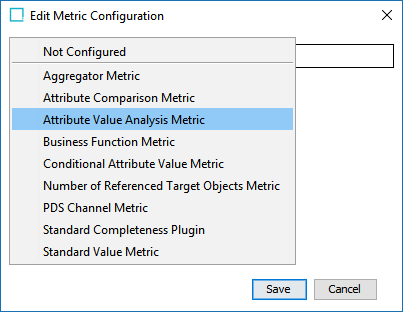
-
Click the selector button (
 ) to select the attribute to analyze, select an operator from the 'Operator' dropdown list, and input a value into the 'Value' text field. Once an operator is selected from the 'Operator' dropdown list, a default error message will appear in the 'Error Message' text field, based on the selected operator.
) to select the attribute to analyze, select an operator from the 'Operator' dropdown list, and input a value into the 'Value' text field. Once an operator is selected from the 'Operator' dropdown list, a default error message will appear in the 'Error Message' text field, based on the selected operator. 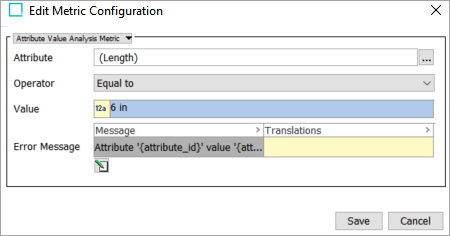
Operator options include:
-
Is empty - disables the 'Value' text field.
-
Is not empty - disables the 'Value' text field.
-
Equal to
-
Not Equal to
-
Contains
-
Regular expression
-
Greater than - only available if the validation base type of the selected attribute allows for numbers.
-
Less than - only available if the validation base type of the selected attribute allows for numbers.
-
Length is equal to
-
Length is greater than
-
Length is less than
In the example screenshot above, the user has selected 'Width' for the attribute and 'Equal to' for the operator. The user wants to know if the value of the 'Width' attribute is equal to '6 in.' If it is, then the returned score will be '100' (true). If it is not, then the returned score will be '0' (false), and this score will be accompanied with a message, as displayed in the 'Error Message' text field.
In this example, the Value text field includes a validation base type of 'Numeric Text' (displayed as '12a'). The validation base type displayed in the Value text field is dependent on the validation base type of the attribute selected by the user for analysis. For information regarding validation base types, refer to the Base Unit ID, Name, and Value Aspects topic in the Data Exchange documentation.
Note: An attribute that is not valid for a product is not applicable for that product metric and no data quality information will be produced when the Sufficiency Data Calculator event processor is run.
-
-
Click the 'Error Message' editor button (
 ) to display the 'Edit messages' dialog which allows you to edit the error message and/or add additional translations.
) to display the 'Edit messages' dialog which allows you to edit the error message and/or add additional translations. 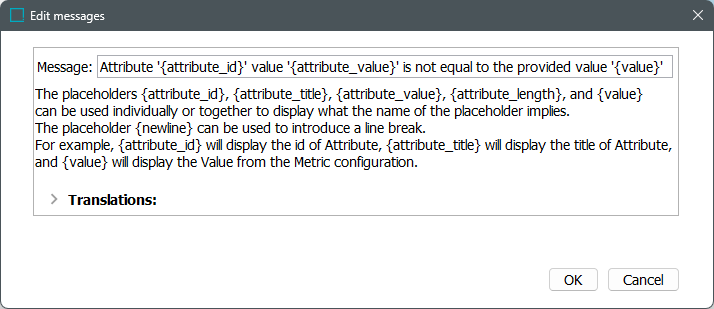
The 'Edit messages' window displays and the 'Message' text field is editable. Descriptive text below the text field describes in detail how the placeholders included in the error message work to create an error message. Although a default error message is suggested, users can edit the error message for the individual need.
Note: Although the error message can be edited by the user, editing the 'attribute_id' and 'attribute_value' placeholders results in a validation error message when attempting to save the edited message. When the metric is run, placeholders are replaced by the 'real values,' e.g., 'attribute_id' would be replaced with the ID of the attribute that the metric is evaluating.
-
Open the 'Translations' section and click the 'Add translation' button (
 ).
). 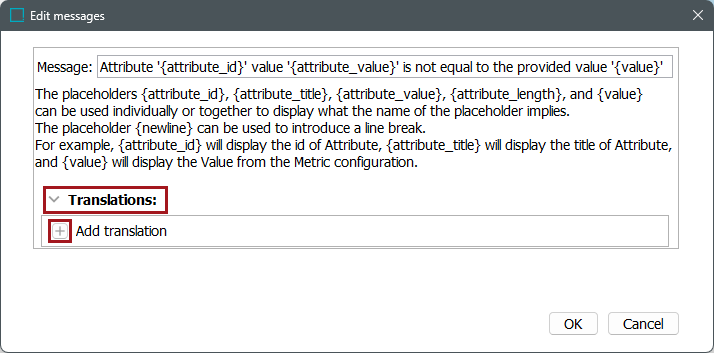
-
Click the 'Language' selector dropdown and choose a language.
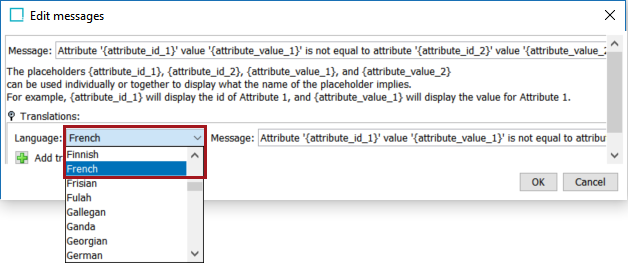
-
In the Message parameter, edit the text to reflect the language specified for translation.
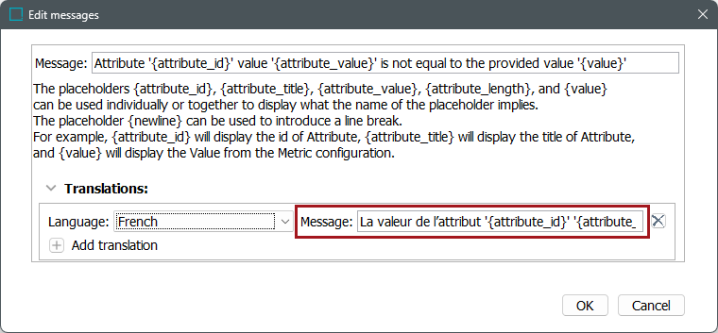
-
Click the 'Add translation' button (
 ) to add another translation or click 'OK' to close the window.
) to add another translation or click 'OK' to close the window. -
Click 'Save' to close the Edit Metric Configuration wizard and save the metric.
Note: Translation error messages are displayed by using locales; they are not context-dependent. For more information about locales, refer to the topic Localization in the Administration Portal documentation. For more information about localized messages, refer to the topic Localized Messages for JavaScript Business Rules in the Business Rules documentation.
Once the metric is added to a sufficiency and the sufficiency is run, the results are displayed in the sufficiency panel within the Web UI. In the example below, the Attribute Value Analysis Metric (titled 'AttC') has been added to the sufficiency 'Product Measurement Requirements,' and returned a score of '100' because the attribute 'Length' value is equal to '6 in,' which was the value input into the metric. Because the returned score is '100' and not '0,' there is no accompanying error message.

Validation Errors
Validation errors can occur depending on the attribute selected for analysis. A validation error message will occur if:
The provided value is not valid based on the selected attribute validation base type.
The selected attribute is multivalued.
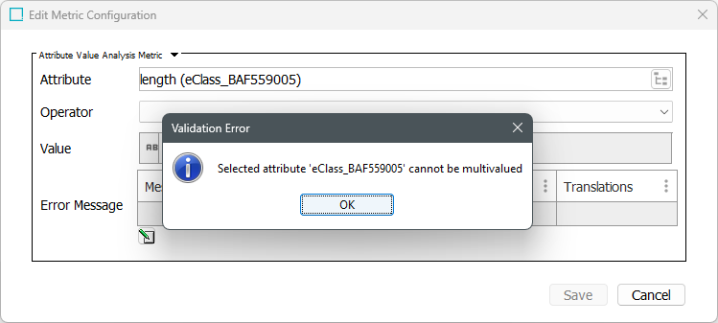
The following instances will also produce validation errors. However, these errors will not appear until the metric is run. The error message will appear in the Background Process Log of the Data Sufficiency Calculator event processor.
The selected attribute has a unit but the value provided by the user in the metric configuration has no unit.
The selected attribute has no unit but the value provided by the user in the metric configuration has a unit.
The selected attribute and the value provided by the user in the metric configuration have different base unit conversion rules.
The selected attribute's unit and/or the value's unit provided by the user in the metric configuration has no base unit conversion rule.
For more information regarding units, including base units and conversion rules, refer to the Units topic in the System Setup documentation